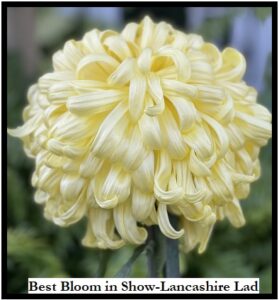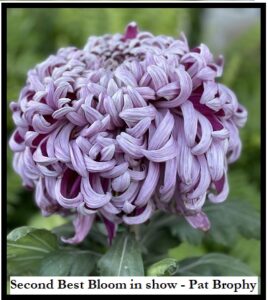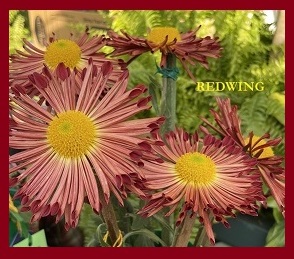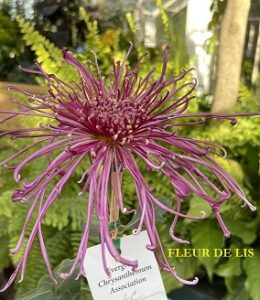When to pot up your Chrysanthemums:
Pot on when a significant ring of roots forms around the bottom edge of the pot (semi root bound). Do not compact the potting mix.
Tie plants to small stakes. Bamboo Skewer stakes work well for 4 inch pots. 12 inch bamboo stakes work well for 6 inch pots.
Move mum pots outdoors as weather warms. Choose a sunny location. Some growers choose to bury pots to rim if using clay. This helps to protect the plants from frost, wind, dogs, cats and children.
Potting medium when potting on mums into 4” or 6” pots:
2 recommendations:
1) Soilless M&R mix – available exclusively to ECA members. This mix is PH balanced at 6.5 and contains a good mix of fertilizers that carry the plant for 3-4 weeks. It requires no additives at this time, however some growers like to add a little Alfalfa meal and some additional pumice for increased aeration.
2) Custom compost mix – See McGlashen mix in the McGlashen Hand Book. You’ll need to mix your own soil, consisting of compost, or garden loam plus slacked Lime or Dolomite to keep soil sweet plus Steamed Bone to promote root growth. Also, ashes and a little Rose and garden fertilizer (i.e. 4-10-8 or 5-10-10) Pumice or grit may be added to loosen the soil mix.
Clay or plastic posts?
Whether the pot is clay or plastic, mineral deposits, and other debris can accumulate that may harbor disease organisms and cause problems for your plants. It is important to clean and disinfect old pots in a mild Clorox (bleach bath) each time you use them. To disinfect pots, soak them in a solution containing one part household bleach to 9 parts water for a minimum of 10 minutes. Rinse in clear water.
Clay pots are recommended for 4 or 6 inch potting because they breathe and dry out faster during cool April days. The porosity of clay allows air and moisture to penetrate the sides of the pot. This moisture and fine air is utilized by the fine roots located at the edge of the soil ball. Clay pots also act like a wick to remove excess moisture from the potting soil. If using plastic pots, water sparingly. Chrysanthemums do not like wet feet. Overwatering when plants are in 4 inch pots may rot the roots.
FERTILIZING: Fertilize weekly starting the 3rd or 4th week after potting using an early season fertilizer. An early season fertilizer 12-45-10 is recommended because it’s high in phosphorus which promotes strong root development. Early season fertilizers should be applied at ½ Teaspoon per gallon of water.
STAKING: For tall varietals use a bamboo skewer and twist ties to support the plant stem
STOPPING/PINCHING:
Sometime between mid-April and mid-June most of the mums need to be pinched. The exception being James Bryant. At our March and April meetings David Rynes provided some excellent background and pinching instructions for James Bryant – basically don’t pinch it at all, let it grow.
Pinching is a form of pruning that encourages branching on the plant. When you pinch a plant you are removing the growing tip, forcing the plant to grow two new stems from the leaf nodes below the pinch or cut. Generally pinch the growing tip off (about an inch) just above the first set of leaves below the growing tip. Once pinched, two or three side shoots will progressively emerge from the leaf axis below the stop. It’s a good idea to keep the upper three to six laterals depending upon the cultivar. Remove all others.
Why pinch between April and mid-June? The pinch date is used primarily to time the mum to reach full bloom at the time of our show (usually the end of October). The club has specific pinching date recommendations for each varietal. With experience, each grower will develop a customized pinch date list reflecting how the mums progress within their particular location. Recommendation: Pinch mums being planted in the garden in mid to late April to produce blooms in September before bad weather sets in. Pinch date lists for most club cultivars are on our website CULTIVARS OF ECA. – www.ecamumclub.org.. pinch lists will also be available at our May meeting
For UK classifications #1 and #2 varieties the English literature recommends a fairly hard pinch; that is pinching 6-8 leafs down from the growing tip. For the incurves, UK classifications #3, #13, #23 pinch the smallest portion of the growing tip to get more uniform growth of the laterals. For all varieties, fertilize 1-2 weeks before pinching to produce more laterals. This is especially true for the Fairweathers.
Fertilizer Education
There are 3 numbers that represent the percentage (by weight) of the three major nutrients required for healthy plant growth – nitrogen-phosphorus-potassium (N-P-K). Each of these nutrients affects plant growth differently. For example, a 5 lb. bag of 10-5-5 fertilizer contains 0.5 lbs. of N, 0.25 lb. of P2O5, and 0.25 lb. of K2O.
The first number is nitrogen. A bag of 24-8-4 has 24 percent total nitrogen. Nitrogen provides plants with the ability to produce more chlorophyll, which in turn allows plants to grow quickly. With each additional nitrogen application, plants will grow taller and develop a darker green color. The second number is phosphorus. A bag of 24-8-4 would contain 8 percent phosphorus. Phosphorous aids in root development and increases flowering ability and bloom size. High-phosphorous fertilizer should be used when plants are being established. The third number is potassium. A bag of 24-8-4 has 4 percent potassium. Potassium guards the plant against diseases and aids in drought protection and cold tolerance. It also serves a role in improving root development and helps in the process of photosynthesis. How does this translate to the fertilizers we use? Early season fertilizer 12-45-10 is high in phosphorus which promotes strong root development. Mid-season (summer) fertilizer 20-10-20promotes overall growth, disease protection, root development & color. Late season fertilizer 4-18-38 is high in potassium which promotes root and top growth and keeps plants healthy and balanced. Fertilizer concentrations – ½ to 1 teaspoon per gallon of water up to 4 inch pots
1 to 2 teaspoons per gallon of water 6 inch and larger pots
Gauge fertilizing – Watch the leaves to gauge the fertilizer needed. If leaves become hard or curled then you are overfeeding. If leaves are weak and lighter green then more fertilizer would help. If leaves are yellow try drying them out. If drying the plant doesn’t help try feeding ½ teaspoon Epsom salts per plant or leaf feed with a liquid iron product like Greenall or Sequesterine. Do not over feed liquid iron
B- Nine Information
B-Nine reduces plant height in ornamental plants by reducing internode length. Other benefits include a deeper green color and reduced breakage during shipping. B-Nine when applied to plant foliage is absorbed into the leaf, moves within the plant to the growing points to reduce internode elongation. If plants don’t have leaves then b9 won’t work. A defoliated plant will not respond to the photoperiodic cycle. … Therefore, in the absence of leaves, light perception would not occur, i.e., the plant would not respond to light.
Solutions prepared from B-Nine should not be held for more than 24 hours.
Apply during morning or evening hours for best leaf absorption.
Use when foliage is dry, apply only on turgid, well-watered plants.
Plants should not be watered for 2-3 hours after application with B-Nine.
Do not tank mix B-Nine with any copper-containing product and do not spray B-Nine within 7 days either before or after copper-containing products, as burning of leaves may result. Always read and follow label directions when using this product.
Under some conditions and on some varieties, B-Nine may delay flowering. It is advisable to test on a small scale any new variety in order to observe the results before large scale use.
Do not mix with any other chemical unless specifically recommended.
Do not use on Chrysanthemum variety Fandango.
Benefits for Chrysanthemums
• To produce stronger stalks and smaller internodes, more well branched and compact plants, reducing damages during transport
• To increase quality and duration of flowering
• Greener foliage
• Increase in root growth, drought and pollution resistance
Early applications
• Use when shoots of plants are maximum 2.5 – 5 cm long,
around 2 weeks after pinching out (topping)
• Repeat the application at 2-3 week intervals
• To avoid flowering delay, do not use B-Nine after budding formation and do not exceed maximum dose rates
Use personal protective equipment PPE
The residues of plant growth regulators PGRs in agricultural products are seriously detrimental to human health.




